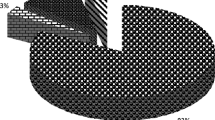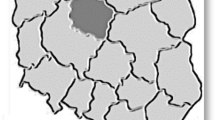Abstract
The study was performed on 20 (10 males, 10 females) roe deer (Capreolus capreolus) to investigate the concentration of cadmium, lead, mercury, and arsenic in the muscle tissue. They reside in forest and meadow, about 50 km distance from industrial activities and traffic. Samples were taken from the musculus biceps femoris of each deer without external contamination after shooting during the regular hunting season on a hunting area close to Eger in Hungary. The determination of heavy metal contents was carried out by inductively coupled plasma optical emission spectrometry (ICP-OES). The statistical analysis was performed by statistical package for the social sciences (SPSS) version 11.0. The measured residue concentration of cadmium was below the limit of detection in the roe deer meat indicating no health risk for the consumers. The average lead concentration (0.48 ± 0.21 mg/kg wet weight) exceeded the regulated maximum limit, but its calculated weekly intake was below the provisional tolerable weekly intake (PTWI). The residue level of mercury is not regulated and the average mercury content of roe deer meat (0.87 ± 0.40 mg/kg wet weight) was about half of PTWI, but the consumption of meat with the highest detected concentrations results in higher PTWI than recommended. The measured concentration of arsenic (0.27 ± 0.20 mg/kg wet weight) in the roe deer meat may not pose any health risk for the human consumers according to the PTWI set by the World Health Organization.

Similar content being viewed by others
References
ATSDR (Agency for Toxic Substances and Disease Registry) (1999a) Toxicological profile for cadmium (final report). NTIS Accession No. PB99-166621. 434
ATSDR (Agency for Toxic Substances and Disease Registry) (1999b) Toxicological profile for lead. Atlanta, GA: U.S. Department of Health and Human Services, Public Health Service
Bargagli R, Baldi F (1984) Mercury and methylmercury in higher fungi and their relation with the substrata in a cinnabar mining area. Chemosphere 13:1059–1071
Bernhoft A (2013) Blyammunisjon forurenser horteviltkjøttet. Nor Vet Tidsskrift 8:501–503
Chilvers DC, Peterson PJ (1987) Global cycling of arsenic. In: Hutchinson TC, Meema KM (eds) Lead, Mercury, cadmium and Arsenic in the Environment. John Wiley & Sons, New York, 279–301
Clarke EGC, Clarke ML (1975) Veterinary toxicology, 3rd edn. Williams & Wilkins, Baltimore, p 477
Commission Regulation (2006) Commission regulation (EC) No 1881/2006 setting maximum levels for certain contaminants in foodstuffs.
Cornatzer WE, Fogarty EF, Cornatzer EW (2009) Qualitative and quantitative detection of lead bullet fragments in random venison packages donated to the community action food centres of North Dakota, 2007. In: Watson RT, Fuller M, Pokras M, Hunt WG (eds) Ingestion of lead from spent ammunition: Implications for wildlife and humans. The Peregrine Fund, Idaho, USA
Demirbaş A (2002) Metal ion uptake by mushrooms from natural and artificially enriched soils. Food Chem 78:89–93
Długaszek M, Kopczyński K (2013) Elemental composition of muscle tissue of wild animals from Central Region of Poland. Int J Environ Res 7:973–978
EFSA (European Food Safety Authority) (2009a) Scientific opinion of the panel on contaminants in the food chain on a request from the European Commission on cadmium in food. EFSA J 980:1–139
EFSA (European Food Safety Authority) (2009b) Scientific opinion on arsenic in food. EFSA Panel on Contaminants in the Food Chain (CONTAM). EFSA J 7:1351
EFSA (European Food Safety Authority) (2010) Scientific opinion on lead in food. EFSA Panel on Contaminants in the Food Chain (CONTAM). EFSA Journal 8:1570
Ehrlich HL, Newman DK (2008) Geomicrobiology. CRC press, Boca Raton, p 265
Elinder CG (1985) Uses, occurrence and intake. In: Friberg L, Elinder CG, Kjelstrom T, Nordberg GF (eds) Cadmium and health: an epidemiologic and toxicological appraisal. CRC Press, Boca Raton, Florida, pp 23–63
Falandysz J (1994) Some toxic and trace metals in big game hunted in the northern part of Poland in 1987–1991. Sci Total Environ 141:59–73
Falandysz J, Borovička J (2013) Macro and trace mineral constituents and radionuclides in mushrooms: health benefits and risk. Appl Microbiol Biotechnol 97:477–501
Falandysz J, Gajda B (1988) Mercury content in muscle, liver and kidneys of slaughtered and game animals from the northern part of Poland, 1985–1986. Roczn Panstw Zakl Hig 39:113–117 (in Polish)
Falandysz J, Kojta AK, Jarzyńska G, Drewnowska A, Dryżałowska A, Wydmańska D, Kowalewska I, Wacko A, Szlosowska M, Kannan K, Szefer P (2012a) Mercury in Bay Bolete Xerocomus badius: bioconcentration by fungus and assessment of element intake by humans eating fruiting bodies. Food Addit Contam A 29:951–961
Falandysz J, Nnorom IC, Jarzyńska G, Romińska D, Damps K (2012b) A study of mercury bio-concentration by Puffballs (Lycoperdon perlatum) and evaluation of dietary intake risks. Bull Environ Contam Toxicol 89:759–763
IPCS (International Programme on Chemical Safety) (1989) Environmental health criteria 85—lead, environmental aspects. World Health Organization, Geneva
Jarzyńska G, Falandysz J (2011) Selenium and 17 other largely essential and toxic metals in muscle and organ meats of Red Deer (Cervus elaphus)—consequences to human health. Environ Int 37:882–888
JECFA-776 (1989) Evaluation of certain food additives and contaminants, 33rd Report of Joint FAO/WHO Expert Committee on Food Additives, Technical report series 776. Geneva
JECFA-959 (2011) Evaluation of certain food additives and contaminants, 72nd Report of Joint FAO/WHO Expert Committee on Food Additives, Technical report series 959. Geneva
JECFA-960 (2011) Evaluation of certain food additives and contaminants, 73rd Report of Joint FAO/WHO Expert Committee on Food Additives, Technical report series 960. Geneva
Jedrychowski W, Perera FP, Jankowski J, Mrozek-Budzyn D, Mroz E, Flak E, Edwards S, Skarupa A, Lisowska-Miszczyk I (2009) Very low prenatal exposure to lead and mental development of children in infancy and early childhood. Neuroepidemiology 32:270–278
Jusko TA, Henderson CR Jr, Lanphear BP, Cory-Slechta DA, Parsons PJ, Canfield RL (2008) Blood lead concentration <10 μg/dL and child intelligence at 6 years of age. Environ Health Perspect 116:243–248
Kalač P, Burda J, Stašková I (1991) Concentration of lead, cadmium, mercury and copper in mushrooms in the vicinity of a lead smelter. Sci Total Environ 105:109–119
Kojta AK, Gucia M, Jarzyńska G, Lewandowska M, Zakrzewska A, Falandysz J, Zhang D (2011) Phosphorous and metallic elements in Parasol Mushroom (Macrolepiota procera) and soil from the Augustowska Forest and Ełk regions in north-eastern Poland. Fresenius Environ Bull 20:3044–3052
Kojta AK, Jarzyńska G, Falandysz J (2012) Mineral composition and heavy metals accumulation capacity of Bay Bolete’s (Xerocomus badius) fruiting bodies collected near a former gold and copper mining area. J Geochem Explor 121:76–82
Kostial K, Rabar I, Blanuša M, Landeka M (1979) Effect of age on heavy metal absorption. Proc Nutr Soc 38:251–256
Laczay P (2015) Contaminants of environmental origin. In: Laczay P (ed) Food hygiene, food chain safety. A/3 Printing and Publishing Ltd., Budapest, pp 91–99
Larsen EH, Hansen M, Gössler W (1998) Speciation and health risk considerations of arsenic in the edible mushroom Laccaria amethystina collected from contaminated and uncontaminated locations. Appl Organomet Chem 12:285–291
Lindboe M, Henrichsen EN, Høgåsen HR, Bernhoft A (2012) Lead concentration in meat from lead-killed moose and predicted human exposure using Monte Carlo simulation. Food Addit Contam 29:1052–1057
Mandal BK, Suzuki KT (2002) Arsenic round the world: a review. Talanta 58:201–235
Medvedev N (1999) Levels of heavy metals in Karelian wildlife, 1989–91. Environ Monit Assess 56:177–193
Michels S (1986) Natural occurrence of arsenic in food. Wiss Umw 3–4:118–122
Nielsen FH (1998) Ultratrace elements in nutrition: current knowledge and speculation. J Trace Elem Exp Med 11:251–274
NRC (National Research Council) (2005) Mineral tolerance of animals. National Academies Press pp 7, 31–37, 115–119, 124–127, 134–143, 199–206, 210–218, 248–250, 255–256, 262–268, 276–280
Ötvös E, Pázmándi T, Tuba Z (2003) First national survey of atmospheric heavy metal deposition in Hungary by the analysis of mosses. Sci Total Environ 309:151–160
Pacyna JM, Pacyna EG (2001) An assessment of global and regional emissions of trace metals to the atmosphere from anthropogenic sources worldwide. Environ Rev 9:269–298
Pokorny B, Al Sayegh-Petkovšek S, Ribarič-Lasnik C, Vrtačnik J, Doganoc DZ, Adamič M (2004) Fungi ingestion as an important factor influencing heavy metal intake in roe deer: evidence from faeces. Sci Total Environ 324:223–234
Ramanzin M, Amici A, Casoli C, Esposito L, Lupi P, Marsico G, Marinucci MT (2010) Meat from wild ungulates: ensuring quality and hygiene of an increasing resource. Ital J Anim Sci 9:318–331
Reglero MM, Monsalve-González L, Taggart MA, Mateo R (2008) Transfer of metals to plants and red deer in an old lead mining area in Spain. Sci Total Environ 406:287–297
Stokke S, Botten L, Arnemo JM (2010) Blyrester fra jaktkuler i viltkjøtt – en helserisiko? Nor Vet Tidsskr 122:407–410
Taggart MA, Reglero MM, Camarero PR, Mateo R (2011) Should legislation regarding maximum Pb and Cd levels in human food also cover large game meat? Environ Int 37:18–25
Tixier H, Duncan P, Scehovic J, Yant A, Gleizes M, Lila M (1997) Food selection by European Roe deer (Capreolus capreolus): effects of plant chemistry, and consequences for the nutritional value of their diets. J Zool 242:229–245
Tsuji LJS, Wainman BC, Jayasinghe RK, Vanspronsen EP, Liberda EN (2009) Determining tissue-lead levels in large game mammals harvested with lead bullets: human health concerns. Bull Environ Contam Toxicol 82:435–439
Waldner C, Checkley S, Blakley B, Pollock C, Mitchell B (2002) Managing lead exposure and toxicity in cow-calf herds to minimize the potential for food residues. J Vet Diagn Invest 14:481–486
Woolson EA (1983) Emissions, cycling and effects of arsenic in soil ecosystems. In: Fowler BA (ed) Biological and Environmental Effects of Arsenic. Topics in Environmental Effects of Arsenic. Topics in Environmental Health, 6, Elsevier, Amsterdam, pp 51–139
Acknowledgement
This research was supported by the 8525-5/2014/TUDPOL grant of the Hungarian Ministry of Human Resources.
Author information
Authors and Affiliations
Corresponding author
Additional information
Responsible editor: Philippe Garrigues
Rights and permissions
About this article
Cite this article
Lehel, J., Laczay, P., Gyurcsó, A. et al. Toxic heavy metals in the muscle of roe deer (Capreolus capreolus)—food toxicological significance. Environ Sci Pollut Res 23, 4465–4472 (2016). https://doi.org/10.1007/s11356-015-5658-1
Received:
Accepted:
Published:
Issue Date:
DOI: https://doi.org/10.1007/s11356-015-5658-1




